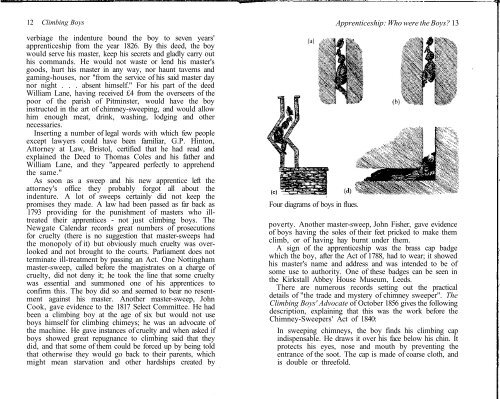Apprenticeship: Who were the Boys? WILLIAM HALL,
Apprenticeship: Who were the Boys? WILLIAM HALL,
Apprenticeship: Who were the Boys? WILLIAM HALL,
You also want an ePaper? Increase the reach of your titles
YUMPU automatically turns print PDFs into web optimized ePapers that Google loves.
12 Climbing <strong>Boys</strong><br />
verbiage <strong>the</strong> indenture bound <strong>the</strong> boy to seven years'<br />
apprenticeship from <strong>the</strong> year 1826. By this deed, <strong>the</strong> boy<br />
would serve his master, keep his secrets and gladly carry out<br />
his commands. He would not waste or lend his master's<br />
goods, hurt his master in any way, nor haunt taverns and<br />
gaming-houses, nor "from <strong>the</strong> service of his said master day<br />
nor night . . . absent himself." For his part of <strong>the</strong> deed<br />
William Lane, having received £4 from <strong>the</strong> overseers of <strong>the</strong><br />
poor of <strong>the</strong> parish of Pitminster, would have <strong>the</strong> boy<br />
instructed in <strong>the</strong> art of chimney-sweeping, and would allow<br />
him enough meat, drink, washing, lodging and o<strong>the</strong>r<br />
necessaries.<br />
Inserting a number of legal words with which few people<br />
except lawyers could have been familiar, G.P. Hinton,<br />
Attorney at Law, Bristol, certified that he had read and<br />
explained <strong>the</strong> Deed to Thomas Coles and his fa<strong>the</strong>r and<br />
William Lane, and <strong>the</strong>y "appeared perfectly to apprehend<br />
<strong>the</strong> same."<br />
As soon as a sweep and his new apprentice left <strong>the</strong><br />
attorney's office <strong>the</strong>y probably forgot all about <strong>the</strong><br />
indenture. A lot of sweeps certainly did not keep <strong>the</strong><br />
promises <strong>the</strong>y made. A law had been passed as far back as<br />
1793 providing for <strong>the</strong> punishment of masters who illtreated<br />
<strong>the</strong>ir apprentices - not just climbing boys. The<br />
Newgate Calendar records great numbers of prosecutions<br />
for cruelty (<strong>the</strong>re is no suggestion that master-sweeps had<br />
<strong>the</strong> monopoly of it) but obviously much cruelty was overlooked<br />
and not brought to <strong>the</strong> courts. Parliament does not<br />
terminate ill-treatment by passing an Act. One Nottingham<br />
master-sweep, called before <strong>the</strong> magistrates on a charge of<br />
cruelty, did not deny it; he took <strong>the</strong> line that some cruelty<br />
was essential and summoned one of his apprentices to<br />
confirm this. The boy did so and seemed to bear no resentment<br />
against his master. Ano<strong>the</strong>r master-sweep, John<br />
Cook, gave evidence to <strong>the</strong> 1817 Select Committee. He had<br />
been a climbing boy at <strong>the</strong> age of six but would not use<br />
boys himself for climbing chimeys; he was an advocate of<br />
<strong>the</strong> machine. He gave instances of cruelty and when asked if<br />
boys showed great repugnance to climbing said that <strong>the</strong>y<br />
did, and that some of <strong>the</strong>m could be forced up by being told<br />
that o<strong>the</strong>rwise <strong>the</strong>y would go back to <strong>the</strong>ir parents, which<br />
might mean starvation and o<strong>the</strong>r hardships created by<br />
(c)<br />
Four diagrams of boys in flues.<br />
<strong>Apprenticeship</strong>: <strong>Who</strong> <strong>were</strong> <strong>the</strong> <strong>Boys</strong>? 13<br />
poverty. Ano<strong>the</strong>r master-sweep, John Fisher, gave evidence<br />
of boys having <strong>the</strong> soles of <strong>the</strong>ir feet pricked to make <strong>the</strong>m<br />
climb, or of having hay burnt under <strong>the</strong>m.<br />
A sign of <strong>the</strong> apprenticeship was <strong>the</strong> brass cap badge<br />
which <strong>the</strong> boy, after <strong>the</strong> Act of 1788, had to wear; it showed<br />
his master's name and address and was intended to be of<br />
some use to authority. One of <strong>the</strong>se badges can be seen in<br />
<strong>the</strong> Kirkstall Abbey House Museum, Leeds.<br />
There are numerous records setting out <strong>the</strong> practical<br />
details of "<strong>the</strong> trade and mystery of chimney sweeper". The<br />
Climbing <strong>Boys</strong>' Advocate of October 1856 gives <strong>the</strong> following<br />
description, explaining that this was <strong>the</strong> work before <strong>the</strong><br />
Chimney-Sweepers' Act of 1840:<br />
In sweeping chimneys, <strong>the</strong> boy finds his climbing cap<br />
indispensable. He draws it over his face below his chin. It<br />
protects his eyes, nose and mouth by preventing <strong>the</strong><br />
entrance of <strong>the</strong> soot. The cap is made of coarse cloth, and<br />
is double or threefold.






